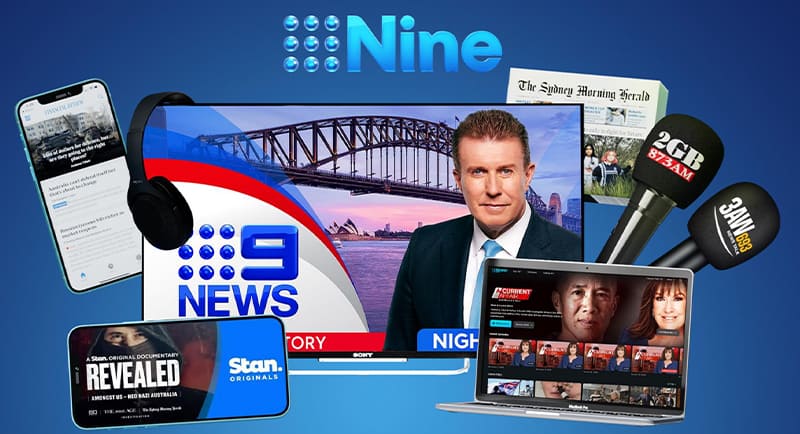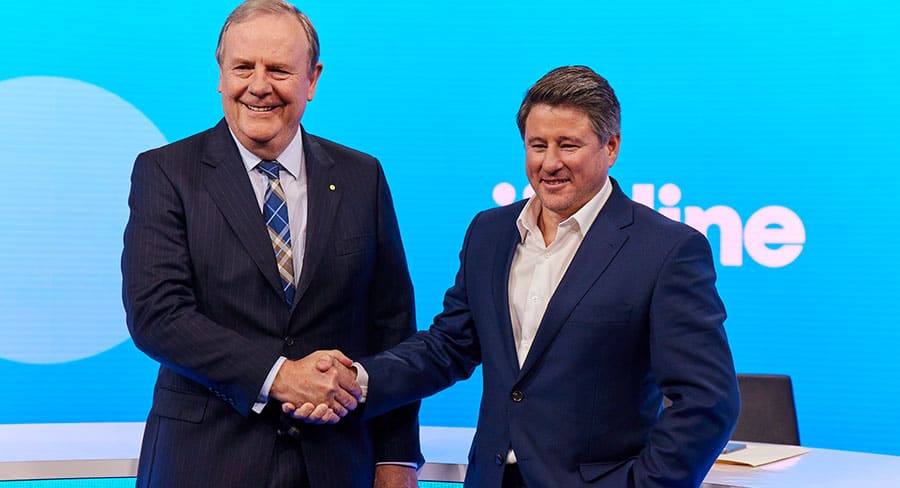Nine Entertainment Co held its Annual General Meeting in Sydney on Thursday morning.
The company’s CEO Mark Sneesby and Chairman Peter Costello provided shareholders with a current trading update and its outlook for FY2023.
Trading Update
“Across Nine’s wholly-owned operations, operating performance for the first half is expected to be broadly in line with previous guidance and company expectation,” Mike Sneesby said.
“Across all of our advertising-driven business, total television, publishing, and radio, Nine believes it has gained share in the first half, and that in FY23, we expect Nine’s advertising revenues to outperform the markets in which we operate.
“The Nine Network and primary Channel Nine will once again win the ratings in all of our targeted demographics (25-54s, 16-39s, and grocery buyers with children) for 2022. Reflecting this strong ratings performance, Nine’s Total TV revenues finished Q1 up around 9% on Q1 of FY22, driven by growth in both Nine Network and 9Now.
“In the December quarter, Nine is expecting a Total TV revenue growth in the low single digits, underpinned by ongoing growth at 9Now.”
Looking ahead, the trading update went on to show that:
Television
• Nine’s Total Television revenue was up c9% in Q1
• Nine currently expects Q2 Total Television revenue growth in the low-single digits
Audio
• Nine Radio ad revenue grew c18% in Q1
• Radio ad market expected to grow in the mid-single digits in H1, on a 4 cap city basis
Publishing
• Q1 saw subscription revenue growth of 5% and total advertising revenues growth of 13%
• Growth is expected to slow in Q2
Stan
• Stan is expect to report revenue and EBITDA growth at Stan in FY23, over FY22
Overall, Nine expects H1 FY23 EBITDA to be around the low end of previous guidance ($380M-400M).
After the AGM, Peter Costello and Mike Sneesby went on to speak at a media conference, where the pair addressed questions asked about Stan, Nine’s publishing arm, and government deals.

Stan
On whether Stan would introduce an ad tier like other streaming services:
Sneesby: “I think the opportunity for advertising in this market on SVOD services, when we look at it from the point of view of a streaming company, is going to be fairly minimal. Look at the upside of more revenue minus the downside that you get from the cost of additional licensing, the cannibalisation of tiers, and the greater complication of the service.
“With Nine, we already have an ad funded platform – and that’s 9Now. We have the opportunity to collaborate between those platforms in constructive ways, as that makes sense. So my position hasn’t changed.
“I think we are in the fortunate position of being in both categories, and having the opportunity to see how this unfolds over the next six to 12 months. If that opportunity seems like it grows for us, then it’s not a significant shift for us to take advantage of it, but we’re going to monitor the market at this stage.”
On Stan subscriber numbers:
Sneesby: “We haven’t given an update on subscriber numbers, but I can say that since the last time that we did report numbers, the numbers are higher.”
On rumours of potentially selling part of Stan:
Sneesby: “In relation to the rumours around a potential sale or partial sale of Stan, there is no process running. The rumours that were reported were not factual. What we have said previously in the market is that if the right strategic opportunities – which may extend to everything from commercial partnerships to more strategic or equity partnerships – if those partnerships make sense for us, then we’re open to considering them. But we’re not in some kind of a sale process on the business.”
Media Code
On whether international deals with Google and Meta will impact Nine’s media code deals:
Costello: “It’s a valuable deal for us – we are performing under it, and they are performing under it. It’s all going as agreed. It has a particular lifetime and it will have to be renegotiated – and you can’t tell what those negotiations will be – but we very much want to renegotiate it. We very much want to continue. It’ll be a question of whether the parties can come to an agreement.
“Now bear this in mind, if we can’t, there is a fallback option under the government’s legislation.”
Nine Publishing
On growing subscriber numbers across Nine’s mastheads:
Sneesby: ”Subscriptions have been going well. You look at it over a long term investment, because you’ll also note that we are making investments into the publishing business that will help underpin that long term growth. Things like greater focus in the in the Queensland market, which we expect to have an opportunity for us to grow audience and subscribers, and investment into important areas of content.
“We’ve spoken about Good Food being one of those ones that we feel is a driver for consumers to pull out their credit card and subscribe. So the trajectory is going well, we are moving forward with those investments.”
On earlier reports of withdrawing newspaper printing from Tasmania:
Sneesby: “We have to constantly look at the profitability of all parts of our business and printing newspapers is part of that. Over time the team in publishing have done a great job at resetting our cost base, particularly in the printing business, to a variable cost base to ensure that we do have a much longer runway. The situation in Tasmania wasn’t a result of making an announcement and responding an outcry. The discussion was taking place, and the final decision hadn’t been made before the information was put into market.
“It wasn’t a case of we did something, we got a backlash, and we changed it. I think the communication to market was just slightly ahead of itself.”
Prominence Legislation
Costello: “The prominence issue is being mainly run by Free TV. It affects all of us, and I think there have been good indications from the government.”
Sneesby: “Free TV is very much aligned on the importance of prominence in the industry, and has taken up the role of putting together commercial television’s view of what that should look like. As part of the consultation process, we have given our views on the details of what we think that could look like.
“One of the key things that we’ve really pushed is when you think about the way that technology is rolling out, ensuring that the government doesn’t just think about how we ensure that there’s prominence on new models of televisions. But also, that prominence applies retrospectively to existing platforms that are in market.”
